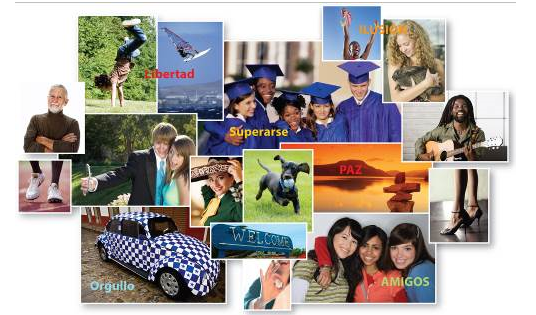Palabras y expresiones absolutas e indefinidas. ¿Qué se ve en este collage? Corrige las siguientes oraciones para que sean ciertas.

1. Hay muchas flores.
___________________________________________________________________
2. Se ve a una persona jugando al fútbol.
___________________________________________________________________
3. No hay nada escrito en otro idioma.
___________________________________________________________________
4. Se ve un desfile (parade) y una frontera.
___________________________________________________________________
5. No hay nadie con barba.
___________________________________________________________________
6. Todo el mundo en estas fotos muestra su pasaporte.
___________________________________________________________________
7. Ninguna foto muestra zapatos.
___________________________________________________________________
8. Hay varias palabras negativas y varias positivas.
___________________________________________________________________
1. No hay ninguna flor.
2. No se ve a nadie jugando al fútbol.
3. Hay algo escrito en otro idioma.
4. No se ve ni un desfile ni una frontera.
5. Hay alguien con barba.
6. Nadie (en estas fotos) muestra su pasaporte.
7. Algunas fotos muestran zapatos.
8. No hay ninguna palabra negativa.
You might also like to view...
This fallacy, instead of proving a claim, diverts attention into other issues
a. Appeal to false authority b. Poisoning the well c. Appeal to bandwagon d. Red herring
The purpose of this selection is to
Levi Coffin’s Reminiscences of the Underground Railroad in the 1850s I was personally acquainted with all the active and reliable workers on the Underground Railroad in the city, both colored and white. There were a few wise and careful managers among the colored people, but it was not safe to trust all of them with the affairs of our work. Most of them were too careless, and a few were unworthy—they 1 could be bribed by the slave hunters to betray the hiding places of the fugitives. We soon found it to be the best policy to confine our affairs to a few persons and to let the whereabouts of the slaves be known to as few as possible. When slave hunters were prowling around the city we found it necessary to use every precaution. We were soon fully initiated into the management of Underground Railroad matters in Cincinnati, and did not lack for work. Our willingness to aid the slaves was soon known, and hardly a fugitive came to the city without applying to us for assistance. 2 There seemed to be a continual increase of runaways, and such was the vigilance of the pursuers that I was obliged to devote a large share of time from my business to making arrangements for their concealment and safe conveyance of the fugitives. They sometimes came to our door frightened and panting and in a destitute condition, having fled in such haste and fear that they had no time to bring any clothing except what they had on, and that was often very scant. The expense of providing suitable clothing for 3 them when it was necessary for them to go on immediately, or of feeding them when they were obliged to be concealed for days or weeks, was very heavy…. Our house was large and well adapted for secreting fugitives. Very often slaves would lie concealed in upper chambers for weeks without the boarders or frequent visitors at the 4 house knowing anything about it. My wife had a quiet unconcerned way of going about her work as if nothing unusual was on hand, which was calculated to lull every suspicion of those who might be watching, and who would have been at once aroused by any sign of secrecy or mystery. Even the intimate friends of the family did not know when there were slaves hidden in the house…. a. explain why Levi Coffin and his wife opposed slavery. b. tell how the Underground Railroad was established. c. explain what the Underground Railroad was intended to accomplish. d. describe how Levi Coffin and his wife assisted slaves to freedom.
Which of the following quotes from the William Cronon essay "‘Only Connect . . .': the
Goals of a Liberal Education" would be acceptable? a. According to teacher and scholar William Cronon, "A liberal education is about gaining the power and the wisdom, the generosity and the freedom to connect" (30). b. Cronon says the word free "goes all the way back to the Sanskrit word rodhati" (27). c. "Liberal education is based on these values: it aspires to nurture the growth of human talent in the service of human freedom" (27). d. Cronon believes that liberally educated people "have the intellectual range and emotional generosity" to be open-minded about ways of looking at the world that differ from their own.
Not only the teacher but also the students _____ ready for spring break
a) is b) are